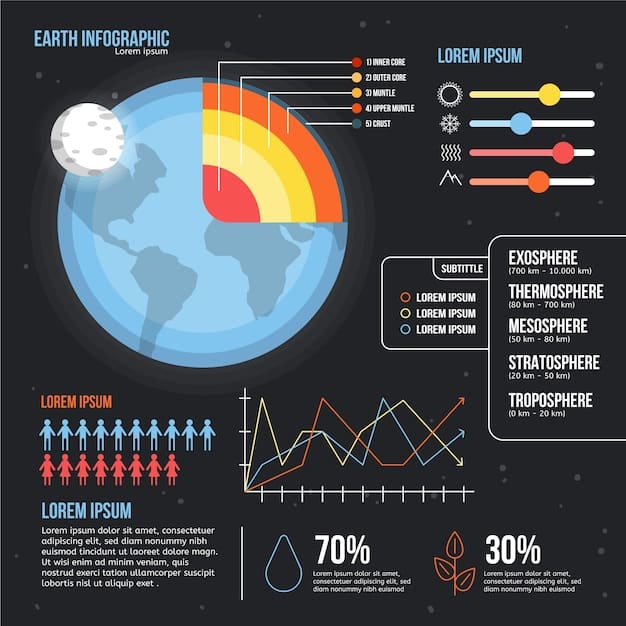Gen Z’s Role in Driving Environmental Sustainability: 10% Carbon Reduction Goal?

The ambitious goal of reducing carbon emissions by 10% within three years through increased awareness and policy hinges significantly on Gen Z’s amplified engagement and unprecedented advocacy in environmental sustainability, leveraging their digital fluency and collective consciousness.
The urgency of climate change has never been more palpable, prompting a global reevaluation of our environmental strategies. Central to this evolving narrative is the pivotal role of Generation Z, a demographic often characterized by its digital native status and fervent social consciousness. Can Gen Z’s Role in Promoting Environmental Sustainability: Can Increased Awareness Campaigns and Policy Changes Reduce Carbon Emissions by 10% in the Next 3 Years? be the catalyst for achieving such an ambitious target?
Gen Z’s Unique Connection to Environmentalism
Generation Z, born roughly between the mid-1990s and the early 2010s, stands distinctively as the first generation to grow up entirely within the digital age. This immersive digital environment has fundamentally shaped their worldview, including their profound connection to environmental issues. Unlike previous generations that might have encountered climate change as a scientific abstract or a distant threat, Gen Z has witnessed its escalating impacts firsthand through a constant stream of information, often unfiltered and immediate.
Their formative years have been marked by increasingly frequent and severe climate-related events, from unprecedented wildfires and devastating storms to persistent droughts and rising sea levels. This constant exposure, amplified by social media and global connectivity, has fostered a deeply internalized sense of urgency regarding environmental degradation. For many, environmental sustainability is not merely an abstract concept but a lived reality and a defining issue of their time, directly impacting their future.
Digital Activism and Awareness Amplification
Gen Z’s innate digital fluency translates directly into their approach to activism. They are adept at utilizing social media platforms, online petitions, and digital campaigns to raise awareness, mobilize peers, and pressure corporations and governments. This digital prowess allows them to bypass traditional media gatekeepers and disseminate information rapidly, often in visually compelling and easily digestible formats.
- Utilizing platforms like TikTok, Instagram, and YouTube to create viral content on climate action.
- Organizing and participating in online protests and digital strikes for environmental causes.
- Sharing verified scientific information and debunking climate misinformation through their networks.
- Leveraging influencer culture to promote sustainable living practices and eco-conscious brands.
This widespread digital engagement has created a powerful echo chamber for environmental discourse, reaching audiences that might otherwise remain unaware or disengaged. Their ability to distill complex scientific data into relatable narratives and emotional appeals is a significant asset in broadening the environmental movement’s reach.
Consumer Choices and Ethical Consumption
Beyond digital advocacy, Gen Z is increasingly demonstrating their commitment to environmental sustainability through their consumer choices. They are more likely to research a company’s environmental record, prioritize ethically sourced products, and support brands aligned with their values. This growing trend towards conscious consumerism holds significant sway in shaping market demands and pushing industries towards more sustainable practices.
From opting for sustainable fashion and plant-based diets to supporting renewable energy solutions, their purchasing power, though nascent, is a growing force that brands cannot ignore. Companies that fail to adapt to these evolving consumer expectations risk losing a generation of loyal customers. This pressure from the demand side complements policy changes by incentivizing corporate responsibility.
Overall, Gen Z’s unique blend of digital savviness, shared global awareness, and ethical consumerism positions them as a formidable force in the ongoing battle against climate change. Their collective actions, whether through online advocacy or everyday choices, are undeniably reshaping the environmental landscape.
Their activism also extends to challenging greenwashing and holding businesses accountable, demanding transparency in supply chains and environmental impact reports. This critical approach ensures that their efforts translate into genuine, measurable change rather than superficial gestures.
The Impact of Increased Awareness Campaigns
Awareness campaigns serve as a foundational pillar in any broad-based environmental initiative, and their impact, when effectively executed, can be profound. With Gen Z at the forefront of digital dissemination, the potential reach and resonance of such campaigns have been magnified exponentially. These campaigns are no longer confined to traditional media but explode across social media, reaching diverse demographics globally.
Modern campaigns, often spearheaded or amplified by Gen Z, are characterized by their innovative approaches, leveraging storytelling, compelling visuals, and interactive elements. They move beyond simple data presentation to evoke emotional responses, fostering a sense of shared responsibility and urgency. This shift from purely informational to emotionally engaging content is critical for driving behavioral change.

Shifting Public Perception and Behavior
Effective awareness campaigns have the power to fundamentally alter public perception of climate change, transforming it from a distant, abstract threat into an immediate, personal concern. When people understand the direct implications for their lives and communities, they are more likely to support and adopt sustainable behaviors. This includes everything from reducing energy consumption at home to advocating for renewable energy policies.
- Normalizing sustainable behaviors like recycling, composting, and reducing single-use plastics.
- Educating the public on complex concepts such as carbon footprints and circular economies.
- Inspiring personal action by showcasing relatable stories of individuals making a difference.
Gen Z’s involvement ensures these messages are delivered in formats and through channels that resonate with younger, digitally-savvy audiences, who are often the hardest to reach through conventional means. Their knack for creating viral content means a single well-crafted message can reach millions in a matter of hours, far surpassing the reach of traditional campaigns.
Influencing Policy and Corporate Accountability
Beyond individual behavior, widespread awareness campaigns generate public pressure that can directly influence policy decisions and corporate practices. When a significant portion of the electorate demands action on climate change, politicians are compelled to respond. Similarly, companies face increasing pressure to adopt sustainable business models when their consumer base calls for it.
Awareness campaigns equip citizens with the knowledge to hold their elected officials and corporate leaders accountable. Armed with information about climate impacts and viable solutions, the public can make informed voting decisions and consumer choices, creating a powerful feedback loop that drives systemic change. The sheer volume of online discourse instigated by Gen Z amplifies this effect.
Moreover, these campaigns often highlight successful case studies of sustainability initiatives at local, national, and international levels, providing tangible examples and blueprints for effective action. By showcasing what’s possible, they inspire further innovation and encourage replication of successful models. This positive reinforcement is crucial for maintaining momentum in a long-term fight against carbon emissions.
The Role of Policy Changes and Legislation
While increased awareness and individual action are vital, achieving significant carbon emission reductions, such as a 10% target in three years, requires robust policy changes and legislative frameworks. Policies provide the necessary structure, incentives, and regulations to drive systemic change across industries and sectors. Without them, individual efforts risk being localized and insufficient to meet global climate goals.
Governments, often spurred by public demand fueled by awareness campaigns, can implement a range of policies designed to curb emissions. These include carbon pricing mechanisms, renewable energy mandates, emissions standards for vehicles and industries, and investments in green technologies. The efficacy of these policies hinges on strong political will and effective enforcement, crucial aspects often influenced by the organized advocacy of groups like Gen Z.
Incentivizing Green Technologies and Practices
Policy changes can accelerate the adoption of green technologies and practices by offering financial incentives, such as tax credits for solar panel installation, subsidies for electric vehicles, or grants for energy-efficient building upgrades. These incentives reduce the economic barriers to adopting sustainable alternatives, making them more accessible and attractive for businesses and individuals alike.
- Tax incentives for businesses investing in carbon capture technologies.
- Subsidies for agricultural practices that promote soil health and carbon sequestration.
- Government-backed loans for renewable energy projects in developing regions.
- Rebates for consumers purchasing energy-efficient appliances.
Furthermore, policies can mandate research and development into new sustainable solutions, fostering innovation and creating a competitive market for environmentally friendly products and services. This not only helps reduce emissions but also creates new economic opportunities, fostering a green economy.
Regulating Emissions and Holding Industries Accountable
Legislation plays a critical role in setting limits on emissions and ensuring industries adhere to environmental standards. Policies can establish cap-and-trade systems, where companies are allocated a certain number of emission allowances, or implement direct regulations on pollution levels from factories and power plants. This regulatory oversight is essential for preventing environmental damage and penalizing non-compliance.
Accountability is further reinforced through transparent reporting requirements and public disclosure of emissions data, allowing for greater scrutiny from both regulatory bodies and the public. Laws requiring environmental impact assessments for new projects also ensure that potential ecological harm is considered and mitigated before development proceeds. Gen Z’s advocacy often zeroes in on these regulatory gaps, pushing for stricter enforcement and expanded coverage.
The combination of regulatory pressure and market incentives, driven by effective policy, creates an environment where businesses find it economically advantageous or legally necessary to reduce their environmental footprint. This powerful synergy between policy and market forces is indispensable for achieving ambitious emission reduction targets within a short timeframe.
Challenges and Opportunities for Achieving the 10% Reduction Goal
The aspiration of reducing carbon emissions by 10% in three years, largely through increased awareness and policy, is audacious and fraught with both significant challenges and compelling opportunities. This target demands an unprecedented scale of coordinated effort, technological innovation, and societal shift. Understanding the landscape of these hurdles and accelerators is crucial for strategizing an effective path forward.
One primary challenge lies in the sheer inertia of existing global economic systems, which are largely reliant on fossil fuels. Transitioning away from this entrenched infrastructure requires massive investment, retraining of workforces, and overcoming powerful vested interests. Additionally, the global political landscape, marked by varying levels of commitment to climate action, introduces complexities in achieving unified, rapid policy implementation.
Overcoming Resistance and Political Divides
Resistance to aggressive climate action often stems from economic concerns, perceived threats to national sovereignty, and the influence of industries that profit from fossil fuels. Political divides within nations, fueled by differing ideologies and short-term electoral cycles, can significantly hinder the passage and enforcement of ambitious environmental legislation. Overcoming these entrenched obstacles requires persistent advocacy and compelling evidence of both the urgency of climate change and the economic benefits of a green transition.
- Building broad political consensus through education and cross-partisan engagement.
- Showcasing economic benefits of green industries and job creation opportunities.
- Countering misinformation and disinformation campaigns against climate action.
- Mobilizing voters to support climate-friendly candidates and policies.
Gen Z’s ability to transcend traditional political boundaries through social media and direct action can be a powerful force in bridging these divides, putting sustained pressure on decision-makers across the political spectrum. Their moral authority, as those most affected by climate inaction, lends weight to their demands.
Leveraging Technological Advancements and Innovation
Despite the challenges, immense opportunities exist through rapid technological advancements. Innovations in renewable energy, energy storage, carbon capture, and sustainable agriculture offer scalable solutions for reducing emissions. Policies that incentivize research and development, along with private sector investment, can accelerate the deployment of these technologies, making them more affordable and efficient.
The global race to develop and deploy green technologies also presents significant economic opportunities, fostering new industries and creating millions of green jobs. By positioning themselves at the forefront of this innovation, nations can gain a competitive advantage while simultaneously addressing climate change. This mutually beneficial scenario can soften resistance by offering tangible economic upsides.
Furthermore, behavioral science and digital tools offer new ways to encourage sustainable lifestyles, from smart home energy management systems to personalized carbon footprint trackers. These technologies empower individuals to make more informed choices, complementing broader policy initiatives and accelerating the shift towards a low-carbon society.
Gen Z’s Potential to Drive Transformative Change
Gen Z’s engagement in environmental sustainability extends beyond mere concern; it embodies a proactive, multifaceted approach to driving transformative change. Their influence is not just theoretical but increasingly manifesting in tangible shifts across various sectors, from consumer markets to political arenas. Their collective identity, deeply intertwined with digital communication and global awareness, positions them uniquely to impact the climate discourse and action.
This generation’s capacity for rapid information exchange and collective mobilization through digital platforms means that ideas, protests, and calls for action can proliferate with unprecedented speed and reach. They are not waiting for traditional institutions to lead, but rather are initiating dialogues, creating content, and forming movements that demand systemic change.
Shaping Future Consumption Patterns
As Gen Z gains more purchasing power, their pronounced preference for sustainable and ethical brands will continue to reshape consumer markets. This shift signals a fundamental reorientation of economic incentives for businesses. Companies that fail to adapt their production processes, supply chains, and product offerings to meet these demands risk obsolescence. This pressure from the demand side is a powerful, market-driven mechanism for emission reduction.
Their advocacy for the circular economy, where waste is minimized and resources are reused, is also gaining traction. This concept, championed by many Gen Z activists, challenges the traditional linear “take-make-dispose” model and promotes a more sustainable industrial ecosystem. Their choices are nudging industries towards greater resource efficiency and reduced environmental footprints, creating a ripple effect that extends far beyond their direct purchasing decisions.
Influencing Political Discourse and Action
The political activism of Gen Z, characterized by their participation in climate strikes, voter registration drives, and online advocacy for specific policies, is increasingly influencing election outcomes and legislative agendas. Politicians are recognizing the growing electoral power of this demographic and the salience of environmental issues to their voting decisions. This translates into greater political will to address climate change and integrate sustainability into policy frameworks.

Their ability to hold elected officials accountable, often through public calls to action on social media, adds another layer of pressure. They are demanding concrete plans and measurable progress, moving beyond vague promises to insist on tangible results. This persistent advocacy helps to ensure that climate commitments are not merely rhetorical but translate into actionable policies with clear objectives.
Fostering Intergenerational Collaboration
While Gen Z leads with fresh perspectives and digital prowess, their impact is amplified through intergenerational collaboration. Many seasoned environmental activists and scientists are finding common ground with younger generations, sharing knowledge, resources, and strategic guidance. This synergy between the energy and innovation of Gen Z and the experience of older generations creates a more robust and effective environmental movement.
Such partnerships facilitate a holistic approach to climate action, combining grassroots activism with institutional advocacy, scientific research, and policy development. This collaborative effort is essential for tackling a challenge as complex and multi-faceted as climate change, ensuring that solutions are comprehensive and sustainable in the long term.
Measuring and Sustaining the 10% Reduction Goal
Achieving a 10% reduction in carbon emissions within three years is an ambitious target that necessitates rigorous measurement, transparent reporting, and sustained effort. Without clear metrics and a continuous feedback loop, it’s impossible to ascertain whether awareness campaigns and policy changes are yielding the desired impact. The efficacy of initiatives must be quantifiable to justify investments and adapt strategies.
Measurement protocols must be standardized and globally recognized to allow for accurate comparisons and accountability. This involves tracking emissions across various sectors—energy, industry, transportation, and agriculture—and assessing the contribution of specific policies and behavioral shifts. The complexity of these measurements requires robust scientific methodologies and sophisticated data analysis tools.
Establishing Clear Baselines and Metrics
For the 10% reduction goal to be meaningful, a clear baseline of carbon emissions must be established. This baseline serves as the reference point against which all progress is measured. Key performance indicators (KPIs) must be defined for each sector and initiative, allowing for granular tracking of emission reductions. These metrics should include not only direct emissions but also indirect emissions related to consumption and supply chains.
- Quantifying direct emissions from industrial processes and power generation.
- Monitoring emissions from transportation, including vehicle mileage and fuel consumption.
- Tracking changes in energy consumption patterns in residential and commercial sectors.
- Assessing the carbon sequestration potential of land use and forestry initiatives.
Regular, transparent reporting of these metrics is crucial for maintaining public trust and ensuring accountability from governments and corporations. Platforms that aggregate and visualize this data, making it accessible to the public, can further empower individuals and organizations to track progress and advocate for continued action.
Ensuring Long-Term Sustainability and Adaptation
Achieving the 10% reduction is only the first step; sustaining and accelerating this progress requires long-term commitment and adaptability. Environmental conditions and technological capabilities are constantly evolving, necessitating a flexible approach to climate policy and action. Policies must be periodically reviewed and updated to reflect new scientific understanding, emerging technologies, and changing socio-economic contexts.
Investment in continuous research and development is vital for discovering new, more efficient ways to reduce emissions and adapt to the impacts of climate change. Public and private partnerships can play a significant role in funding this innovation, ensuring a steady pipeline of solutions. Furthermore, fostering a culture of environmental responsibility through ongoing education and community engagement is essential for embedding sustainable practices into daily life.
Ultimately, the success of the 10% reduction goal hinges on a perpetual cycle of awareness, policy implementation, measurement, and adaptation. Gen Z’s role in this cycle will be pivotal, not only in driving initial momentum but also in sustaining the long-term vigilance and innovation required to secure a sustainable future.
Global Collaboration and Intergenerational Unity
Addressing a challenge as monumental as climate change, especially with an ambitious target like a 10% carbon emission reduction in three years, transcends national borders and requires unprecedented global collaboration. No single nation or generation can tackle this crisis alone. The interconnectedness of global ecosystems and economies necessitates a coordinated international response, where resources, knowledge, and best practices are shared freely and effectively.
While Gen Z is undoubtedly a driving force, their efforts gain exponential power when integrated into a larger framework of intergovernmental agreements, international treaties, and cross-cultural initiatives. This unity ensures that localized successes contribute to a cumulative global impact, preventing emissions from simply shifting from one region to another.
Strengthening International Climate Agreements
International climate agreements, such as the Paris Agreement, provide the essential framework for global collaboration on emissions reduction. These agreements set common goals, define pathways for achieving them, and establish mechanisms for accountability. Strengthening these agreements by fostering greater ambition, ensuring compliance, and expanding participation are critical steps towards a 10% reduction goal.
- Encouraging more nations to adopt and implement ambitious Nationally Determined Contributions (NDCs).
- Facilitating technology transfer from developed to developing nations for green energy solutions.
- Establishing robust international monitoring and verification systems for emissions data.
- Promoting climate finance to support adaptation and mitigation efforts in vulnerable countries.
Gen Z’s global connectivity, their ability to communicate across cultures, and their shared sense of urgency can act as a unifying force, pushing national leaders to prioritize international cooperation over narrow self-interests. Their digital platforms become global megaphones for unified climate action.
Building Bridges Through Intergenerational Partnerships
The environmental movement is becoming increasingly intergenerational, bridging the enthusiasm and digital acumen of Gen Z with the experience and political leverage of older generations. This unity is crucial for developing holistic solutions that address both immediate climate challenges and long-term systemic issues.
Experienced policymakers and scientists can provide the institutional knowledge and scientific rigor necessary for effective climate action, while Gen Z can infuse the movement with innovative communication strategies, grassroots energy, and a fresh sense of urgency. This collaborative approach recognizes that every generation has a vital role to play in securing a sustainable future, and that shared purpose amplifies impact.
Furthermore, intergenerational dialogues foster mutual understanding, allowing for the transfer of wisdom and the cultivation of new leadership. This ensures that the momentum gained from initial campaigns and policy changes is sustained over decades, adapting to new challenges and continuing to drive progress towards carbon neutrality and beyond. The future of environmental sustainability hinges on this ongoing, collective effort.
| Key Point | Brief Description |
|---|---|
| 🌍 Gen Z’s Digital Activism | Leveraging social media for widespread awareness and mobilization on environmental issues. |
| 📊 Policy & Awareness Synergy | Increased awareness fuels public demand for policy changes, accelerating emission reduction goals. |
| 🌱 10% Target Feasibility | Ambitious, but achievable with substantial political will, technological adoption, and sustained Gen Z advocacy. |
| 🔄 Measuring Progress | Crucial to establish baselines, clear metrics, and transparent reporting for accountability and adaptation. |
Frequently Asked Questions About Gen Z and Environmental Sustainability
Gen Z influences environmental policy primarily through digital activism, grassroots organizing, and emphasizing climate issues during elections. Their use of social media platforms creates significant public pressure, forcing politicians and corporations to address sustainability concerns and adopt more eco-friendly practices. This continuous advocacy translates into demands for legislative action and transparent accountability.
The 10% carbon reduction goal within three years is highly ambitious, signifying a rapid acceleration in climate action. It highlights the urgent need for substantial, immediate changes to mitigate the worst impacts of climate change. Achieving this target would demonstrate unprecedented global commitment and the effectiveness of combined awareness and policy strategies.
Gen Z’s consumer habits significantly affect corporate sustainability by prioritizing ethically sourced products and environmentally responsible brands. Their economic power, though growing, is already influencing market demands, compelling companies to adopt more sustainable practices, reduce their carbon footprint, and be transparent about their supply chains. Brands risk losing this critical demographic if they do not adapt.
While awareness campaigns are crucial for shifting public perception and inspiring individual action, they are unlikely to achieve significant carbon emission reductions alone. They must be coupled with robust policy changes and legislative frameworks that incentivize sustainable practices across industries, regulate emissions, and provide accountability. Awareness creates the demand, but policy provides the means and structure.
Technological advancements play a crucial role by providing scalable solutions for reducing emissions, such as renewable energy, carbon capture, and energy storage. Policy changes can accelerate the development and deployment of these innovations through incentives and funding for research. Combining technological progress with policy and awareness efforts is essential for rapidly achieving ambitious emission reduction targets.
Conclusion
The ambitious three-year target of a 10% reduction in carbon emissions, driven by increased awareness campaigns and policy changes, underscores the critical juncture at which global environmental efforts stand. At the heart of this transformative potential lies Gen Z, a generation uniquely equipped with digital fluency and an inherent understanding of climate urgency. Their pervasive digital activism, coupled with an increasing influence on consumer markets and political discourse, provides a powerful catalyst for change. While challenges such as political inertia and economic transitions persist, the synergistic combination of Gen Z’s advocacy, innovative awareness strategies, and supportive legislative frameworks offers a credible pathway toward this demanding goal. The journey demands relentless measurement, adaptation, and a unified global resolve, demonstrating that the future of environmental sustainability hinges significantly on the collective actions and sustained commitment ignited by this influential generation.





